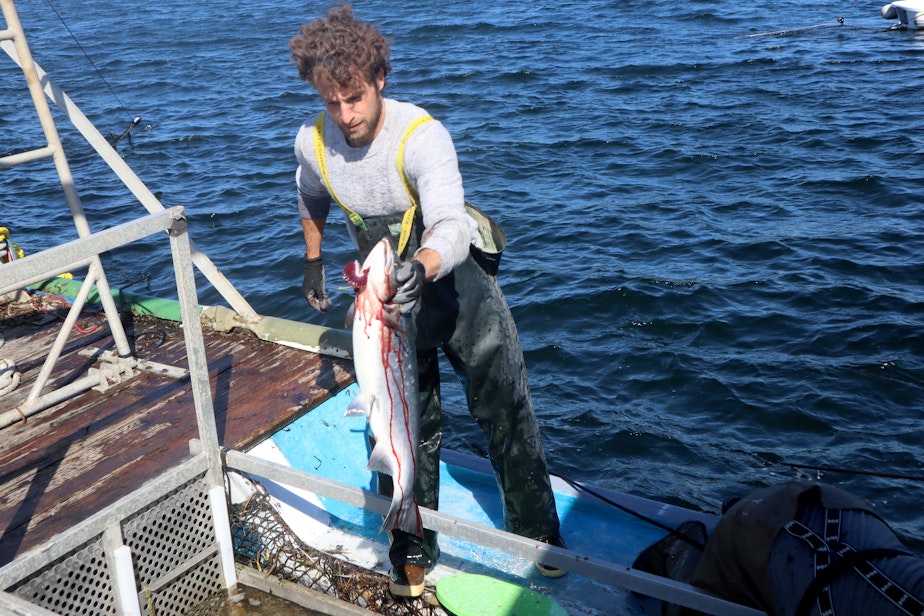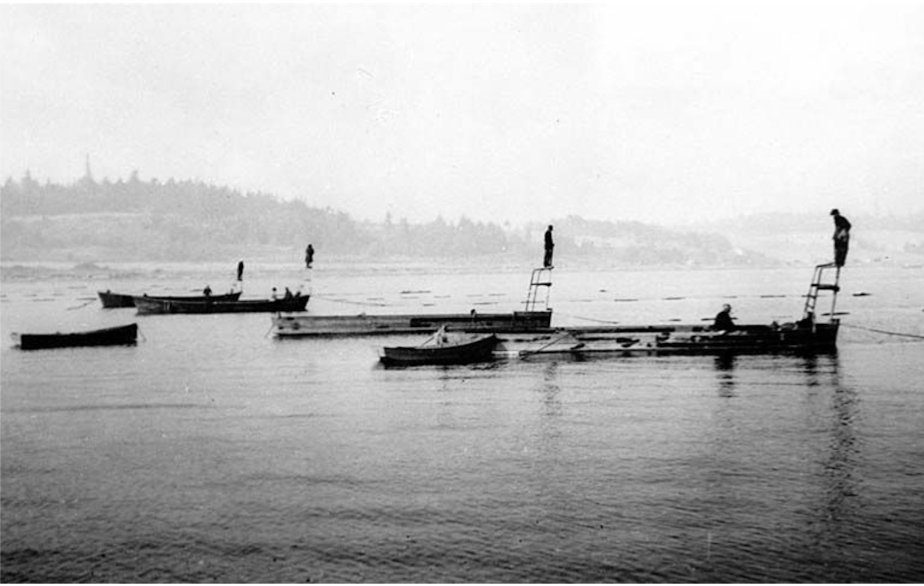The last of the Salish Sea reefnetters don't want to be the last
Only 12 commercial fishing captains still hold permits to go reefnet fishing in the Pacific Northwest out of a fleet that once numbered in the hundreds. The distinctive fishing technique dates back thousands of years as an Indigenous method to catch salmon. Its practitioners today say the gear should proliferate as the preferred way to harvest healthy salmon runs while avoiding fragile stocks.
If you are among the minority of people who have seen the rare and eye-catching reefnet fishing contraptions on the water, you likely remember the sight. A spotter on a swaying tower, and often a second spotter watching underwater camera feeds, alerts the crew to quickly lift the net when they spy the flashes of a school of salmon entering the net strung between two pontoon barges. The small barges are anchored in front of a funnel of lines and ribbons facing the incoming tide — that, the artificial reef that gives reefnetting its name.
"It's really an amazing thing this exists and the way it's all done," said Matthew King, who took a sabbatical from his Los Angeles-based job in commercial real estate development to join a reefnet crew for the summer. "It's been a thrilling experience to say the least."
King was part of the crew led by commercial reefnet fisherman Riley Starks, whose gear is anchored at the end of a row of other reefnet rigs in Legoe Bay on the west side of Lummi Island in North Puget Sound. The 2022 season started with one day of fishing for prized Fraser River sockeye, then seven days for coho in September and now chum salmon in October.

Sponsored
Starks is passionate about wanting to bring reefnetting back to the mainstream. He even founded a nonprofit for that called the Salish Center for Sustainable Fishing Methods.
Sponsored
“This would thrive. It’s a fun, fun fishery,” Starks said about the modernized version of the ancient fishing practice.
But more important than fun, he said, was this fishery's selectivity. The fancy word for the societal good is reducing “bycatch mortality,” as in not inadvertently killing the protected Chinook salmon that endangered orcas need to eat.
"When the other gear types go out, they assume that a certain amount will be killed," Starks said. "They assume zero will be killed here."
Starks made the remark after watching his longtime crewmember Roger Kubalek sort the morning catch in a live holding tank. Kubalek gently lifted a big fat chum salmon, an out-of-season species on that September day, and tossed it back into the sea unharmed. A wild Chinook also turned up swimming along with the targeted coho run and was released.
The strong current carried away those lucky fish. But reefnetting’s fans are definitely paddling against the tide.
Sponsored
Just one tribal reefnet gear remains in active use. Eleven non-tribal permits exist for the region around Lummi Island and the San Juan Islands. But the gears are not fished much because teetering Fraser River and Puget Sound salmon runs allow for only about twenty fishing days per year, Starks said.
"The reason people don't want to reefnet is because we're given so little time, so we can't really catch much. But we could catch much if we were given the time," Starks said. "It's a Catch-22 situation."
"Change is hard," he continued, while acknowledging that other more popular commercial fishing methods are a lot more profitable.
Cross-border interest among some tribal members, too
Separately, members of several Salish Sea tribes have put on reefnet workshops and demonstrations to revive interest in what for them is an age-old tradition that has almost winked out. Lummi Nation fisherman Troy Olsen was one of those organizers who showed tribal youth how suspend the net in the original way between two canoes. He said the onset of the coronavirus pandemic put the Lummi reefnet revitalization project on ice and the gear is presently in storage with uncertain future prospects.
Sponsored
Across the U.S.-Canada border on Vancouver Island, the WSÁNEĆ (Saanich) First Nation was inspired to launch a project to build a culturally accurate reefnet gear partly as an outgrowth of one member's master's thesis at the University of Victoria. The traditional fishing method completely disappeared in British Columbia waters after the government banned reefnets just over a century ago by categorizing them with illegal fish "traps."
"We are heading in the right direction by revitalizing this technology that was outlawed by the government," Reef Net Program leader Landon Underwood said in a WSÁNEĆ blog post. "Last year we made the net and had problems with it being tangled, this year we had no problems getting it out and hopefully next year we will catch some fish.”
Olsen said the economics and logistics of commercial reefnet fishing are daunting — not the least of which because a permit holder must also secure close by and invariably pricey waterfront land from which to stage the operation. But he said there was a cultural imperative for reefnetting to survive.
"Today, we see it as a commodity. But it's more than a commodity. It's something that belongs in the Salish Sea. It was there and it should always be there," Olsen said by phone during a pause between setting and pulling a gillnet on the Nooksack River.
The Lummi Nation could potentially issue new reefnet fishing permits if fishing families were interested, but there are no outward signs anyone new wants to make the investment.
Sponsored

Sponsored
Non-tribal commercial reefnet licenses were capped about two decades ago by the Washington State Department of Fish and Wildlife. Starks said increasing the cap would require either a lasting rebound in salmon stocks or reallocating other Puget Sound gear permits to reefnet practitioners. The latter would be politically "dangerous," he observed, though that didn't stop him from teeing up the idea of making reefnetting the primary method of harvesting salmon in the Salish Sea.
"As a commercial fisherman, you don't want to stick your neck out and say anything derogatory about other gear types," Starks said. "I'm to the point — I'm 72 now — I honestly don't care anymore what other people think. I know what is right."
Starks' nonprofit, the Salish Center, is taking a decidedly modern tack to fundraise for an education and advocacy push. Starks described a plan to create and sell non-fungible tokens — or NFTs — this coming fall and winter. The collectible digital instruments would depict individual orcas from the Pacific Northwest's critically endangered Southern Resident killer whale pods to underscore the connection to Chinook salmon and sustainable fishing methods.
"You have to take the big picture and see what are people interested in," Starks said with a laugh. "We have to go meet people where they are."
Copyright 2022 Northwest News Network

